The natural presumption is to believe that organizational change becomes much harder with more people.
In other words, the more people in an organization, the more difficult it is to change and the longer it will take. While this is not a faulty assumption, it isn’t perfectly accurate either.
All organizations of size are made up of teams of teams. Even in organizations of hundreds of thousands of associates, a fairly small number of team leaders drive the enterprise.
The largest organizations in the world rely upon roughly 250 or fewer team leaders to push toward results and carry the strategy and message of the enterprise.
That means the pace and capacity to change an organization depend more upon the practices of those team leaders than simply the size of the workforce.
Successful, long-standing, and highly cohesive organizations of any size are exceedingly difficult to change or transform, but it comes down to the team leaders who influence the trajectory and focus of the enterprise.
Four qualities associated with those team leaders, not size, are the best predictors of how quickly, easily, and seamlessly an organization can make a major change.
The first quality is team leader subscription. Are the team leaders fully bought in to the change, and are they willing to do what it takes to propel that transformation forward? The more team leaders who are on board and committed to the change, the higher the likelihood of success.
The second quality is the messaging about the change. Do the team leaders embrace the communication strategy, and will they stay on that message, repeating it as often as they can? Organizational change depends on a backdrop of consistent messaging explaining what the leadership is asking others to do.
Modeling the change is the third quality. Do the team leaders showcase that they themselves have accepted the change and are behaving consistently with what it requires? In far too many change efforts, team leaders don’t display their commitment through actions.
The fourth quality is about what team leaders expect of their team members. What are the specific behaviors and practices that will set the change in motion? If team leaders do not hold team members accountable for behaving differently, then the change will likely stall.
Size undoubtedly matters when it comes to making an organizational change, for no other reason than the complexity involved with more people.
But when team leaders buy into the change, stay on message, model what they ask of others, and require team members to enact the practices that support the change, the likelihood and speed of success go way up.

Does Size Matter When It Comes to Organizational Change?
Sign-up Bonus
Enter your email for instant access to our Admired Leadership Field Notes special guide: Fanness™—An Idea That Will Change the Way You Motivate and Inspire Others.
Inspiring others is among the highest callings of great leaders. But could there be anything you don’t know, you haven’t heard, about how to motivate and inspire?
Could there really be a universal principle that the best leaders follow? A framework that you could follow too?
There is.
Everyone who signs up for Admired Leadership Field Notes will get instant access to our special guide that describes a powerful idea we call Fanness™ (including a special 20-minute video that really brings this idea to life).
